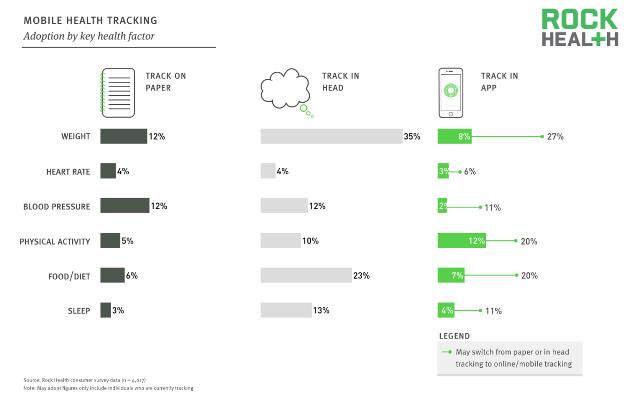Four out of five internet-connected adults use some kind of digital health technology, according to a new report on consumer health trends by seed investor Rock Health.

Rock Health identified six different categories of digital health use: searching for online health information, comparing health services online, tracking health with a mobile app, tracking health with a wearable device, using telemedicine, and using consumer-facing genetic services.
Twenty percent hadn't adopted technology in any of the categories, while 2 percent were "super adopters" using all categories or all but one.
To look at the trend of consumer health engagement another way, more than half of the 4,000 internet-connected adults surveyed said they felt responsible for their own health -- though that responsibility only seemed to extend so far.
"While 52 percent of consumers strongly agree they are responsible for their own health, only 7 percent would say the same about their willingness to pay out-of-pocket for healthcare," report authors Malay Gandhi and Teresa Wang wrote, noting that 31 percent say they are "actively taking care of their health."
Searching online for health information was the most popular technology by far. Seventy-one percent of connected adults told Rock Health they looked online for health information, and 50 percent used online health reviews.
The most common search was for prescription drug information, followed by searches for a medical diagnosis, searches for information on supplements, and searches for treatment options for patients with an existing diagnosis.
Of those, people found their searches for diagnosis most actionable: 45 percent who searched for a diagnosis proposed that diagnosis to their physician. Overall, 40 percent of people who made an online search for health information acted on the results of their search in some way.
As for reviews, respondents were most likely to search for physician reviews online (44 percent) followed by hospitals (33 percent). Searches for nursing homes and professional caregivers were less common, with 10 percent and 7 percent of respondents respectively looking online for those services.
Just 17 percent of respondents used health tracking apps and only 12 percent used wearables. Rock Health asked, for a number of health metrics, whether people were more apt to track them on paper, with apps, or just in their heads -- a question that the Pew Internet and American Life project famously asked back in 2012.
It turns out that in 2015, physical activity is the one thing people are more likely to track via an app than on paper or in their heads. Twelve percent use apps compared to 5 percent who use paper and 10 percent who track in their heads. People are slightly more likely to track sleep and diet via an app than on paper, but still most likely to track both in their heads.
Additionally, Rock found that 63 percent of wearable owners bought the device for themselves, but 25 percent of them said they did so "as an experiment". This might go a ways toward explaining reports that wearables don't retain users.
"There are likely two major contributors to the attrition and rapid engagement decay rates noted in many other surveys," Rock Health authors wrote. "First, 28 percent of individuals are receiving wearables as a gift; and second, of those who purchase, 25 percent cite that they are doing so as an experiment. The implication of the second reason is that they do not set out with long-term ownership interest."
Only 7 percent of the survey group used telemedicine, and they were more apt to use email or texting than video to interact with doctors. Between email, text, and video, email has the highest adoption (28 percent) and the highest satisfaction (76 percent). Text messaging comes in second with 12 percent adoption and 73 percent satisfaction, and video visits trail with 7 percent and 72 percent, respectively.
"While video-based telemedicine is the least utilized medium today, nearly half of video-based telemedicine usage has occurred in the past three months, suggesting it is entering a rapid growth phase, particularly as consumers become more comfortable with video-based technologies (e.g., Facetime) overall," Gandhi and Wang noted.
Finally, Rock Health found that 92 percent agree or strongly agree that they should be the one to control their health data. But they're willing to share that data: 80 percent would share it to get better care from their doctor, 59 percent would contribute it to medical research, 52 percent would do it for discount health insurance, and 39 percent would just sell it for money -- with no information about how it would be used.


















